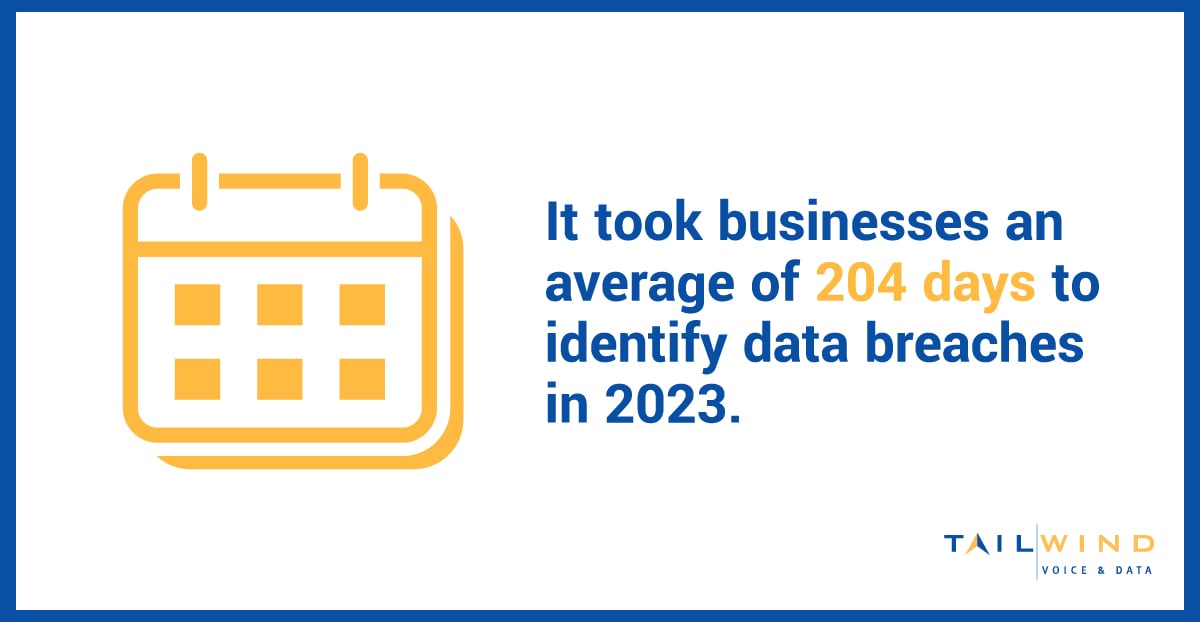Network security has become a critical priority for enterprises as cyber threats grow more damaging each year. Recent data illustrates the escalating threats; average data breach costs now exceed $4.45 million, a 15% increase over the past three years.1 And with the cost of cyber attacks on the global economy predicted to top $10.5 trillion this year,2 implementing robust network security monitoring and response is no longer optional for organizations.
In this guide, we'll explore the critical importance of network security monitoring for businesses today – and how the right technology partner can help strengthen your enterprise security posture.
What Are the Goals of Network Security Monitoring?
Network security monitoring (NSM) refers to continuously monitoring a network to detect security incidents and potential vulnerabilities. The main goals of network security monitoring are to gain visibility into network activity, identify security threats and anomalies, and enable quick response to minimize damage from cyber incidents.
With network security monitoring, security teams can detect attackers and malicious activity by analyzing network traffic patterns and logs. Advanced network security monitoring software applies analytics and machine learning to baseline typical network behavior and identifies deviations that may represent a security threat. This allows businesses to rapidly detect and shut down attacks before they infiltrate sensitive systems and data.

Network Security Monitoring vs. Network Monitoring
While network monitoring solutions focus on availability, performance, and network health, network security monitoring specifically looks at network activity from a security perspective. Primary differences between these software solutions include:
- Detecting Threats - The primary goal of network security monitoring is to detect security threats, including both known malware and attacks, as well as new zero-day exploits and insider threats based on behavioral analysis. Network security monitoring uses techniques like deep packet inspection, anomaly detection, and signature-based detection to pinpoint malicious activities. A network monitoring tool may send generic alerts when there are network performance issues but do not detect specific attack vectors.
- Continuous Baselining - Network security monitoring establishes a baseline of normal network traffic volumes, sources, destinations, payloads, and other attributes. It analyzes ongoing traffic for anomalies and outliers that deviate from the baseline that could represent an attack. Network monitoring software simply looks at bandwidth usage, latency, jitter, and other metrics to ensure availability and performance but does not detect changes in traffic patterns.
- Full Packet Inspection - Network security monitoring software inspects the full contents of network packets and metadata to identify indicators of compromise, malicious traffic, and communication with known bad domains/IPs. Network monitoring examines packet metadata like source, destination, size, and transmission speed but does not analyze payload data.
- Proactive Threat Hunting - NSM solutions provide the ability to search through historical network data to uncover evidence of security incidents that may have been missed initially. This allows for proactive threat-hunting exercises to find low and slow attacks. Basic network monitoring does not have the capability to store and search through large volumes of traffic data to enable threat-hunting activities.
- Interfacing With Other Security Tools - Modern NSM tools integrate with other security systems like SIEMs, firewalls, endpoint detection and response, and more to trigger automatic security alerts and remediation actions when threats are detected in network traffic sessions. Network monitoring software does not interface with these security controls.
Network Security Monitoring vs. Intrusion Detection Systems
While IDS tools play a role in network security monitoring, NSM takes a broader approach focused on full network visibility, rapid detection, and threat intelligence. Some differences between these include:
- Internal Traffic Analysis - Legacy IDS is typically deployed to inspect inbound perimeter traffic at network gateways but lacks visibility into internal east-west traffic between endpoints across the extended enterprise network. NSM monitors critical internal network operations to detect lateral movement and insider threats.
- Detecting Sophisticated Threats - Basic IDS relies on pre-defined signatures and rules to detect known threats and malware. NSM leverages advanced machine learning techniques to establish baseline traffic patterns and identify unknown threats and anomalies that could evade signature-based detection.
- Continuous Adaptive Analysis - IDS conducts static analysis, matching traffic to predetermined signatures and rules. NSM employs continuous analysis that adapts detections and baselines as the threat landscape evolves to identify new attack techniques.
- Proactive Threat Hunting - IDS is reactive, passively monitoring traffic on the wire and preventing or detecting attacks in real time. NSM enables proactive threat-hunting exercises by allowing analysts to search through historical activity logs and flows to uncover evidence of breaches or compromised systems.
- Centralized Visibility - IDS deployments tend to be siloed, placing sensors at different network ingress and egress points. NSM consolidates network security analysis and monitoring into a centralized system for improved visibility and detection accuracy.

What Are the Benefits of Network Security Monitoring?
Implementing network security monitoring offers enterprise businesses several advantages, such as:
Early Threat Detection
In 2023, it took businesses an average of 204 days to identify data breaches.3 Network security monitoring can help organizations detect threats from attackers before they can infiltrate sensitive systems by continuously analyzing network traffic and logs for anomalies. Early detection gives security teams a better chance of containing potential threats before they are able to move laterally and cause damage.
Reduced Incident Response Time
NSM platforms constantly monitor and flag network activity for anomalies in real time, enabling businesses to respond to and remediate security events much faster. Network security monitoring minimizes dwell time – the period that attackers are active within systems but undetected – reducing costs and damage from security incidents.
Insights for Better Defenses
The intelligence gathered by network security monitoring helps organizations gain visibility into the specific cyber threats targeting them based on their vulnerabilities, industry, geography, and other factors. These insights allow them to strengthen defenses and tune policies to better prevent future attacks.
Prioritized Investigations
A 2022 survey found that 94% of security professionals find false positives in vulnerability reports.4 Network security monitoring tools analyze and correlate event data to identify the most likely threats facing the business. This allows network administrators to focus on investigating and responding to the true positives rather than getting bogged down chasing false alarms.
Improved Compliance
Maintaining effective network security monitoring programs and capabilities is required under various regulatory compliance frameworks like HIPAA and PCI DSS. Network security monitoring provides the necessary audit trails and reporting.
Essential Features of Network Security Monitoring Software
Effective network security monitoring requires advanced technologies and capabilities, including:
Continuous Monitoring
Network security monitoring tools must provide persistent 24/7 visibility into activity across the entire network attack surface. Gaps in coverage, especially of internal network segments, remote locations, and cloud environments, can make it easy for network administrators to miss key threat indicators.
Analytics for Threat Detection
NSM platforms apply statistical analysis, machine learning, behavioral modeling, and other techniques to baseline normal network behavior and identify abnormal activity that may represent a security risk. This provides the ability to detect and respond to zero-day and sophisticated threats that evade traditional signature-based protections.
Powerful Log Management and Correlation
Network security monitoring relies on log data generated from endpoints, servers, network devices, security tools, and other systems. Robust log aggregation, normalization, and correlation capabilities are essential to identify threat patterns from disparate events.
Retrospective Analysis
Analyzing historical network sessions and event data enables NSM solutions to identify previously missed security threats and uncover trends that can improve detections going forward. Lookback analysis is key to continuous improvement.
Centralized Management
Consolidating network security monitoring in a unified view with centralized management streamlines investigations when threats are detected, enabling faster, coordinated response actions across the security infrastructure.
Customizable Reporting
Network security monitoring platforms should provide customizable reporting to meet the needs of different teams and stakeholders. Reports help demonstrate program effectiveness and compliance.
Scalability
Network security monitoring solutions must be able to scale easily to handle high network traffic volumes across distributed multi-site environments without compromising network performance or security data collection.1

Enterprise Network Security Monitoring With TailWind NOCaaS
Network security monitoring is critical for protecting enterprise businesses from today's advanced security threats. Unfortunately, implementing an effective in-house network monitoring program can be resource-intensive and expensive. Partnering with a network operations center as a service (NOCaaS) provider like TailWind allows enterprises to benefit from 24/7 network security monitoring and expert threat detection – without the overhead of building internal network monitoring and security operations centers.
Our NOCaaS solution offers:
- Local and Accountable Support - We provide on-site support from field techs across North America who operate as an extension of your IT team.
- Scalable Infrastructure Management - We'll get to know your operations, so we’re always ready to address your unique needs and fill security gaps with the correct resources.
- End-To-End Solutions - We own your tickets from start to finish, providing true end-to-end network management and complete visibility with real-time tracking.
- Reduced Costs and Risks - We'll leverage our experience, practices, and toolsets to reduce your high fixed NOC costs and eliminate downtime risks.
Ready to learn more about leveraging TailWind's NOCaaS solution for enterprise network security monitoring? Contact us today to get started.
Sources:
- https://www.ibm.com/reports/data-breach
- https://www.ibm.com/blog/top-concerns-industry-leaders-have-about-cyberattacks-in-2024-and-beyond
- https://www.statista.com/statistics/1417455/worldwide-data-breaches-identify-and-contain
- https://www.infosecurity-magazine.com/opinions/false-positives-burn-teams-out


